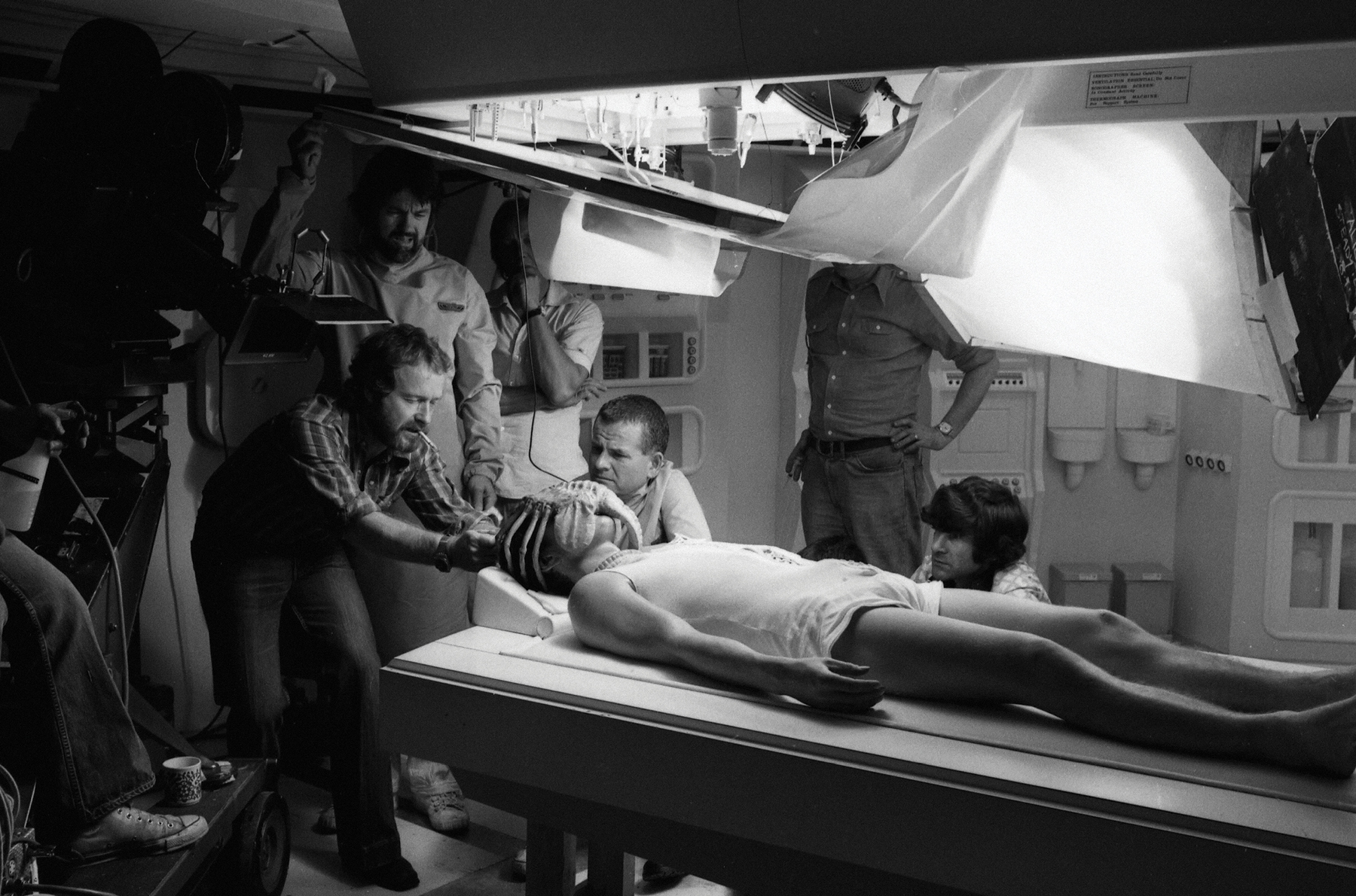1979
DIRECTOR: RIDLEY SCOTT PRODUCERS: GORDON CARROLL, DAVID GILER, AND WALTER HILL SCREENPLAY: DAN O’BANNON STARRING: TOM SKERRITT (DALLAS), SIGOURNEY WEAVER (RIPLEY), VERONICA CARTWRIGHT (LAMBERT), HARRY DEAN STANTON (BRETT), JOHN HURT (KANE), IAN HOLM (ASH), YAPHET KOTTO (PARKER)
Alien
TWENTIETH CENTURY-FOX • COLOR, 117 MINUTES
The crew of a deep-space towing ship picks up an uninvited passenger when they stop to investigate a distress signal.

If Star Wars (1977) and Close Encounters of the Third Kind (1977) made science fiction exciting again, Alien single-handedly made the genre (in the words of the Hollywood Reporter) “scary as hell.” At once low-key and profoundly shocking, director Ridley Scott’s 1979 space thriller is often ranked among The Exorcist (1973) and Jaws (1975) as one of the most nightmare-inducing films of all time. Like its titular monster, Alien slowly coils its slimy tentacles around the audience and never lets go.
Once his gamble on Star Wars proved an overwhelming success, Twentieth Century-Fox mogul Alan Ladd Jr. (son of classic movie star Alan Ladd) easily convinced the studio to bank on another sci-fi screenplay. Dan O’Bannon’s script, originally titled Star Beast, “was derived from a million science-fiction movies I absorbed while growing up,” O’Bannon said. The screenwriter wove together elements from shockers such as It! The Terror from Beyond Space (1958), Planet of the Vampires (1965), and, most obviously, The Thing from Another World (1951)—even down to the crew’s overlapping dialogue—to form Alien. Visually, the film appropriates the used, grimy look of the spacecraft in Star Wars to add a gritty realism. Though it borrows from previous works, Alien retains its integrity as a strikingly original story in its own right; its deadly life-form that gestates inside a human body is one of the most frightening concepts imaginable.

Sigourney Weaver as Ripley with her cat, Jonesy

John Hurt gives birth to a baby alien.

The crew of the Nostromo (L to R): John Hurt, Veronica Cartwright, Tom Skerritt, Yaphet Kotto, Sigourney Weaver, Harry Dean Stanton, and Ian Holm
Ridley Scott, who had only TV commercials and one feature (The Duellists [1977]) under his belt at the time, fought for the opportunity to direct Alien, which he envisioned as “The Texas Chain Saw Massacre of science fiction”—in other words, a slasher movie set in outer space. Scott takes his sweet time at the film’s start, gradually building a subtle sense of foreboding as he establishes the seven crew members of the Nostromo, recently awakened from hypersleep to discover a fossilized alien ship. When certain studio executives saw the movie and complained, “But nothing happens in the first forty-five minutes,” Scott replied, “Well, that’s the whole point.” As critic Roger Ebert once observed, “It isn’t the slashing that we enjoy. It’s the waiting for the slashing.”
When the alien finally appears, it does not disappoint. Young Swiss illustrator H. R. Giger designed the xenomorph he described as “elegant, fast, and terrible,” and Carlo Rambaldi (who went straight from Close Encounters to Alien) created the creature’s eyeless, streamlined head. The film’s trendsetting production design reflected the sleek new breed of movie monster. Glistening with condensation and billowing with vapor, the dimly lit, steamy corridors of the Nostromo would become de rigueur for sci-fi cinema in the 1980s. The whole experience was minimalist and ahead of its time, from Jerry Goldsmith’s stark score to the lowercase-only typeface of the screen credits, a style that would later become associated with the Internet era.
Fox’s marketing campaign set new standards, too. No clips or photography from the film appeared in the TV ads or theatrical trailers—only the image of an alien egg cracking open and the now-legendary tagline, “In space, no one can hear you scream.” In an unusual strategy for an R-rated horror film, Fox had a line of toys and collectible merchandise manufactured, counting on Alien to be a blockbuster. When he first saw rushes of Scott’s work, Ladd had upgraded the production from a B picture to a big-budget extravaganza. He also approved the switch of two of the crew members from male to female.
As the smart, self-possessed warrant officer Ripley, Sigourney Weaver was transformed by Alien from an unknown stage actress into the first female sci-fi action hero. Her revolutionary role literally made headlines: “The Hero Is a Woman” announced a 1979 Los Angeles Times article. “What Lee Marvin and Charles Bronson were to The Dirty Dozen, Sigourney Weaver is to Alien, a hero as opposed to a heroine (who is usually saved by the hero),” proclaimed the Times. In 1986, James Cameron would step in as director and push Ripley even further into action-hero stardom with his acclaimed high-octane sequel Aliens. “Just call me Rambolina,” Weaver joked of her famed character. With or without Ripley, the Alien franchise continues to thrive in the twenty-first century. Ridley Scott returned to direct a sixth installment, Alien: Covenant, in 2017.
KEEP WATCHING
PLANET OF THE VAMPIRES (1965)
OUTLAND (1981)



